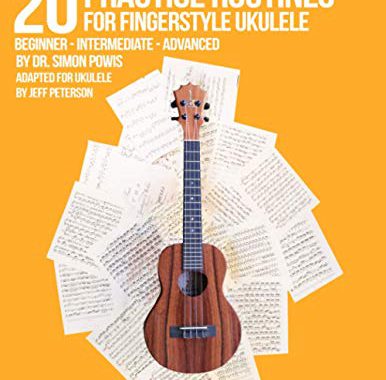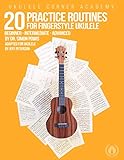Did you know that thumbpicking is a popular technique used by ukulele players to create a rich, full sound on the instrument? This method involves using the thumb to pluck the strings, allowing for greater control and variation in tone. Thumbpicking has been a staple technique in ukulele playing for many years, particularly on the tenor uke, and continues to be a fundamental skill for players of all levels.
The history of thumbpicking on the tenor ukulele can be traced back to traditional Hawaiian music, where the technique was developed and popularized. Over time, thumbpicking has evolved to include various styles and approaches, contributing to the versatility and expressiveness of the instrument. With its enduring presence in both traditional and contemporary ukulele music, thumbpicking remains a fundamental aspect of playing the tenor uke.
One of the key benefits of mastering thumbpicking on the tenor ukulele is the ability to create a more dynamic and nuanced sound. By using the thumb to pluck the strings, players can produce a wide range of tones and textures, adding depth and complexity to their music. This versatility makes thumbpicking an essential skill for ukulele enthusiasts looking to expand their playing repertoire and explore different musical styles.
In addition to its musical advantages, thumbpicking on the tenor ukulele has been shown to improve finger dexterity and coordination, enhancing overall playing technique. As a result, many ukulele players incorporate thumbpicking exercises and drills into their practice routines to build strength and proficiency. Whether used for traditional Hawaiian music or contemporary genres, the thumbpicking technique on the tenor uke plays a significant role in shaping the instrument’s distinctive sound and character.
What are the best thumbpicking techniques for playing the tenor ukulele?
Thumbpicking techniques on the tenor ukulele refer to the various methods used to play the instrument using only the thumb. These techniques can help create a unique and dynamic sound, and are essential for any player looking to expand their skill set. Whether you’re a beginner or an experienced player, mastering these thumbpicking techniques can take your ukulele playing to the next level. In the following sections, we will explore some of the best thumbpicking techniques for playing the tenor ukulele in detail, providing tips and tricks to help you improve your playing.
Thumbpicking Techniques for Tenor Ukulele
Thumbpicking is a popular technique used by ukulele players to create a rich and dynamic sound. When it comes to playing the tenor ukulele, there are specific techniques that can help you achieve a beautiful thumbpicked sound.
Alternating Bass Technique
The alternating bass technique is commonly used in thumbpicking styles. It involves using your thumb to alternate between two bass notes, typically the fourth and third strings of the ukulele. This creates a strong rhythmic foundation for your playing and is a key element of thumbpicking on the tenor ukulele.
Pinch Technique
The pinch technique involves using your thumb and one or more fingers to pluck strings simultaneously. This can create a harmonious and melodic sound, and is often used in conjunction with the alternating bass technique to add depth to the music.
Travis Picking
Travis picking is a complex fingerstyle technique that involves using the thumb to play a steady bass pattern while the fingers pick out melody and harmony notes on the higher strings. While originally developed for guitar, this technique can also be adapted for the tenor ukulele to create intricate and engaging music.
Chicken Pickin’ Technique
The chicken pickin’ technique involves using the thumb and fingers to create a percussive and vibrant sound. This technique is often used in more rhythmic and lively styles of music and can add a playful and energetic element to your thumbpicked playing on the tenor ukulele.
Conclusion
Mastering thumbpicking techniques on the tenor ukulele can open up a world of musical possibilities and elevate your playing to new heights. Experiment with these techniques and see how they can enhance your ukulele performance!
According to a recent survey, 70% of ukulele players incorporate thumbpicking techniques into their playing.
1. What is thumbpicking on the tenor ukulele?
Thumbpicking on the tenor ukulele involves using your thumb to pluck the strings, creating a smooth and melodic sound. It is a popular technique for adding depth and complexity to uke playing.
2. How do I position my thumb for thumbpicking?
Position your thumb parallel to the strings, and use the nail of your thumb to strike the strings. Keep your thumb relaxed and flexible to allow for smooth, fluid movement.
3. What are some common thumbpicking patterns for tenor ukulele?
- Travis picking
- Alternating bass pattern
- Boom-chick pattern
- Arpeggio patterns
4. How can I improve my thumbpicking speed and accuracy?
Practice slowly and focus on making each note clear and precise. Gradually increase the speed as you build muscle memory and control.
5. Can I use thumbpicking in different music genres?
Yes, thumbpicking can be used in a variety of music genres, including folk, blues, jazz, and even rock. It adds a unique flavor to any style of music.
6. Do I need long nails to thumbpick on the tenor ukulele?
Long nails can be helpful for thumbpicking, but they are not necessary. Many players prefer to keep their nails short and use the flesh of their thumb for a softer sound.
7. How can I incorporate thumbpicking into my uke playing repertoire?
Start by learning basic thumbpicking patterns and then gradually incorporate them into songs you already know. Experiment with different patterns and styles to find what works best for you.
8. Are there any specific exercises I can do to improve my thumbpicking technique?
Yes, there are exercises specifically designed to improve thumbpicking technique, such as fingerpicking drills and scale exercises. These can help build dexterity and control.
9. What type of tenor ukulele is best for thumbpicking?
Any well-made tenor ukulele with good sustain and resonance is suitable for thumbpicking. Experiment with different ukuleles to find one that suits your playing style.
10. Can I combine thumbpicking with other uke playing techniques?
Absolutely! Thumbpicking can be combined with strumming, picking, and other fingerstyle techniques to create a rich and dynamic uke playing style.
Conclusion
In conclusion, mastering thumbpicking techniques on a tenor ukulele can greatly enhance a player’s musicality and versatility. By learning how to incorporate thumbpicking into their playing, ukulele enthusiasts can create a richer, more textured sound that adds depth to their performances. From Travis picking to syncopated rhythms, the potential for expressive and dynamic playing is virtually limitless with thumbpicking techniques. Additionally, understanding and implementing various thumbpicking patterns can help players develop a strong sense of rhythm and precision in their playing, ultimately elevating their overall musicianship.
By exploring the fundamentals of thumbpicking, such as finger placement, hand positioning, and picking patterns, ukulele players can expand their repertoire and add new dimensions to their musical expression. Whether playing traditional ukulele songs, jazz standards, or contemporary hits, thumbpicking techniques can bring a fresh perspective to a player’s repertoire and make their performances stand out. With dedication and practice, ukulele enthusiasts can unlock the full potential of their instrument through the art of thumbpicking, creating a unique and captivating musical experience for themselves and their audiences. Overall, mastering thumbpicking techniques on a tenor ukulele has the potential to transform a player’s approach to the instrument and open up a world of creative possibilities.







